7 AI Tools Enhancing Software Development at Netguru

Where generative AI tools for software development may be heading? Not an easy task to guess. QuantumBlack, predicts a few different evolutions in generative AI tools for software development.
Among others, we can expect them to use more senses. They will listen to you, see you, and speak to you in a human-quality voice, and complete even more complex tasks like analyzing facial expressions and sensing moods. You will speak to them, too; they will no longer be confined to mere text.
Software development AI tools’ ability to access data will be enhanced through better connections to the internet, and data warehouses. These AI tools will also tap into IoT sources and virtually every permissible, non-air-gapped space to collect and collate data.
They will become deterministic. Learning will eliminate millions of potential answers in favor of small pools of extremely likely answers, and ultimately, one response to a specific situation, providing more consistent results.
Democratization will prevail as open-source models spread—this makes them viable in private scenarios.
These trends are transforming business operations by integrating advanced AI tools into the development process. Engineers and developers can now use them not only to analyze designs and understand code, but to outsource some of the tasks from people.
In this article, I’ll show you how you can make better, faster decisions, leverage deep learning and generative AI, and optimize your AI software development tools, just the way we do here at Netguru. I’ll also tell you why it’s these exact tools that are currently among the best choices.
The best AI development tools for developers
Copilot
At Netguru, nearly 100 engineers use Github Copilot on a daily basis to carve off hours of development process time every day. If you can accomplish in a mere five minutes something that would have required 35 minutes on your own, you are well ahead of the game.
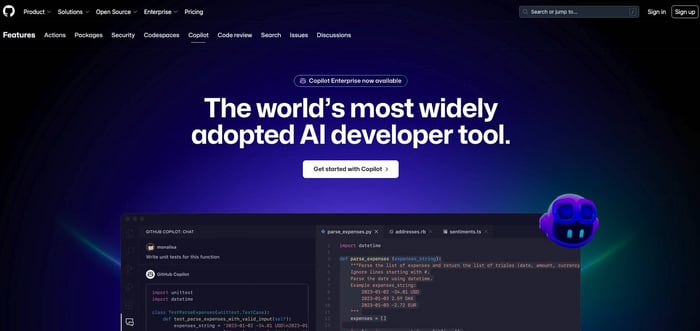
What is Copilot
Copilot, by GitHub and OpenAI, is an AI-driven code completion tool that assists developers by offering real-time code suggestions. Trained on extensive open-source code, it understands multiple programming languages and integrates into editors like Visual Studio Code, enhancing productivity with relevant code snippets and algorithms.
How does Netguru use it?
Imagine you're faced with a poorly documented block of code written by a former employee. Using the /explain command, you can type in plain English, "Please explain this config," and Copilot will analyze it, see its links and imports, and offer an explanation in seconds. This saves hours compared to manually debugging code.
Here’s what engineers at Netguru say:

.jpg?width=700&height=365&name=Quote%20template%20-%20Quote%20%2B%20Person%20%2B%20Role%20%2B%20Their%20pic%20-%20Dark%20-%203%20(3).jpg)
Copilot key benefits
Increased productivity:
Copilot can generate entire lines writing code or blocks of code, including functions and algorithms, saving developers time and effort in writing repetitive or complex code. This allows developers to focus on genuine problem-solving and create higher-level design faster.
Wide language and framework support:
Copilot supports many coding languages like Python, JavaScript, TypeScript, Ruby, Go, C# and C++, allowing developers to get assistance across projects and various programming languages. This gives versatility across multiple techstacks.
Learning and discovery:
The suggestions provided by Copilot often act as a teaching aid for developers. They can learn previously unconsidered coding techniques and efficiencies or alternatives to arrive at smarter solutions.
Integration with Popular IDEs:
GitHub Copilot seamlessly integrates with popular code editors like Visual Studio Code, Vim or JetBrains IDEs, providing real-time suggestions and feedback as you write code.
Help with learning new languages:
Copilot supports multiple programming languages, allowing developers to get assistance across various projects. You are able to quickly acquire new syntax of language and you don’t get so frustrated with writing for-loops in different ways.
Accessibility for solo developers and small teams:
You can think of Copilot as an additional team member of sorts. It can provide suggestions or fully formed solutions to evolving problems, saving immense amounts of time. Spend more time “developing” and less time “troubleshooting”.
Efficient time usage:
Does it save a lot of time for our developers? Yes, frequently! We ran a study among 32 engineers who use GitHub Copilot, and discovered significant efficiency improvements. On average, they saved 5-10% of their time, which indicates a productivity boost.
GPT-Engineer
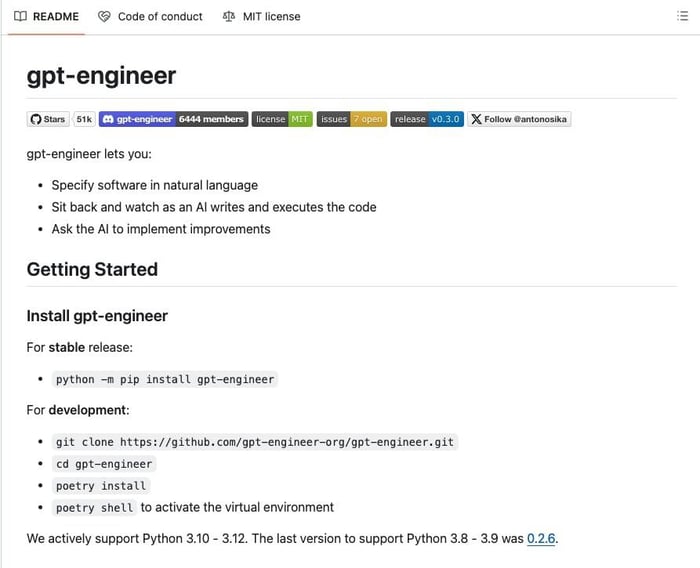
What is GPT-Engineer
GPT-Engineer is an AI-powered tool designed to assist in software development by automating coding tasks, analyzing designs, and generating code based on user input. I predict that this application builder might evolve into an even more powerful solution than Copilot. It is still in the early days, but I believe GPT-Engineer will be better equipped to handle more complex cases.
How does Netguru use it?
GPT-Engineer generates impressive code complexity with minimal user input. The code quality spans from good to excellent, and it is quite easy to use.
It does very well with many programming languages, and possesses a particular proficiency in Java, much to our delight. In fact, at Netguru, it’s our recommended tool for speeding up project setup.
This AI tool has proven its worth, and its iterative approach allows for efficient improvement of code through simple prompt adjustments.
At Netguru, GPT-Engineer streamlines our own software engineering and development processes by offering a dependable foundation for our code reviews and initiating projects.
It works best if we:
- Enhance the quality of the generated code by using detailed and explicit prompts, which then help guide the AI to produce more accurate outcomes.
- Combine multiple AI development tools with GPT-Engineer to overcome inherent limitations with all such tools. We also utilize AutoGPT since it can complete tasks autonomously, so it can refactor the code.
- Evaluate GPT-Engineer regularly and update it, informed by the performance and internal or external advancements of the tool itself.
- Ensure human oversight remains integral throughout the code generation process, particularly in autonomous modes. This lets us rectify any discrepancies and uphold project standards in the generated code.
GPT-Engineer key benefits
Saving time and effort
By automating the code generation process, GPT-Engineer significantly reduces the time and effort required for software application development. Developers can speed up projects by using generated code as a foundation, allowing them to refine and customize instead of starting from scratch.
Increasing developer efficiency and productivity
Performing routine coding tasks can become tedious so let the machine handle these tasks. This frees up creativity for more critical project aspects such as design, testing, and optimization.
Locofy.ai
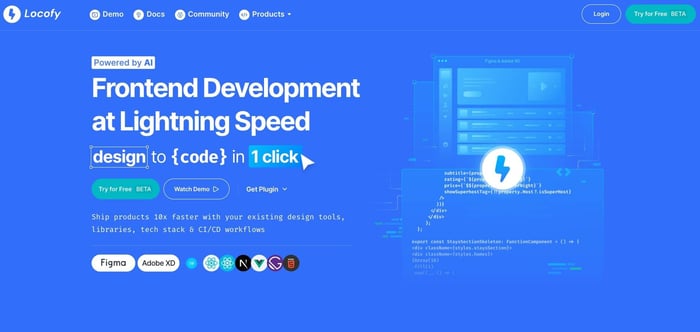
What is Locofy
Locofyis another AI tool that we use, which as the name hints, enables low-code software development. You put your designs on one end and usable code comes out the other – of course, the business logic is still entirely in your hands. It’s a remarkable time-saver. It distinguishes itself with broad compatibility across design tools, libraries, tech stacks, and CI/CD workflows, promising that users will be able to deliver products up to 10 times faster.
It converts design into usable code with styling, using React and Tailwind. It speeds up the creation of visuals so our frontend developers can focus more on business logic and product delivery.
How does Netguru use it?
Our developers use it to generate code for web development. There are already a few commercial implementations on the market where we used Locofy, including one for the Cardano Foundation where we were responsible for creating the About Page.
In one experiment, our engineer, Kamil Stawski, generated an entire Homepage utilizing just TypeScript and CSS Modules. Locofy took input, and crafted the entire project, complete with configuration files, package.json, and routing setup!
The code was meticulous and accurate and the quality was beyond my expectations. It was well-structured react code, and efficiently divided the code into logical sections and components.
These components came with passed props, type definitions, and were presented clearly and consistently throughout the codebase. Even the overall naming conventions were essentially accurate, rendering code that was readable and easily maintainable.
Here are a few takeaways I’d like to share from using Locofy:
- Go through several rounds of design optimization before using the Locofy plugin.
- Eliminate pointless groupings and don’t apply layout features so the plugin isn’t constrained. It will help the end result fit better on the wide variety of screens and resolutions it will encounter.
- Tag your elements so they can be identified and manipulated easily.
- Integrate actions such as scrolling into view, page transitions, and opening/closing popups, to give life to the design.
Ultimately, you’ll generate the code, sync it with Locofy Builder, and pass it on to the development team.
Locofy key benefits
Design optimization: It primes designs for further development by fine-tuning Figma files for coding.
Rapid prototyping with Locofy Prototype: It bridges the gap between design and functionality by generating functional prototypes using real code. As a result, you have the ability to iterate designs quickly.
Locofy Builder: The IDE (Integrated Development Environment) boosts coding productivity and elevates code production, all while fostering team growth.
Streamlining frontend development: The tool excels in accurately translating designs into code, ensuring that the user interface remains faithful to the intended designs.
Enhancing team collaboration: You can eliminate communication barriers between designers and developers by letting Locofy.ai automate the design-to-code conversion.
Scaling product development: Maintaining a cohesive user experience across a growing product line is vital. As your business expands, Locofy.ai plays a key role in swiftly developing consistent frontend components.
Integrating with CI/CD pipelines: Its compatibility with CI/CD workflows enables smooth integration of designs, which is essential for agile teams prioritizing rapid product iterations.
Azure GPT
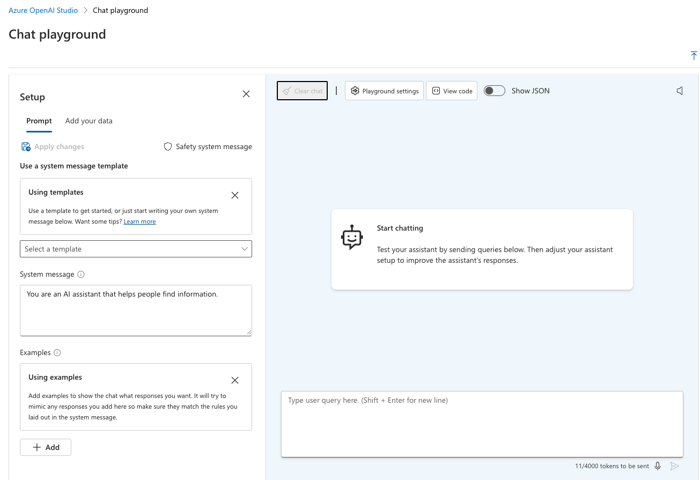
What is Azure
Azure GPT is a dedicated instance of GPT chat interface hosted on our infrastructure, providing support to developers while coding. It offers features such as asking questions, engaging in discussions on various topics, and accessing live support while learning. Powered by Azure's AI-optimized infrastructure, it ensures efficient performance and reliability.
Here’s how it works:
We consolidated information between our Customer Relationship Management system, our documents, and our internal wikis. This enables employees to ask any question they like, and receive answers in just seconds, complete with links to the original sources that inspired the answers.
How does Netguru use it?
This is an internal program just for our own use. Our team members have the opportunity to participate in dynamic, interactive discussions with GPT-4 regarding the projects or issues they are exploring.
Personally, I have witnessed significant success in incorporating it into our R&D project documentation. I am confident that the introduction of this tool has opened up a wide variety of opportunities for effortless information exchange. This benefit extends to both the development team and the broader organization.
In this example you can see how I've employed it to acquire information on Netguru’s Mobile Diffusion project:
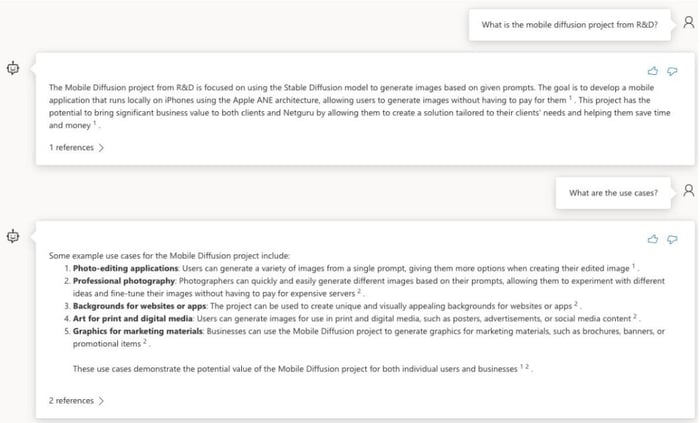
AI development tools; example from Netguru’s Mobile Diffusion project
More importantly, each user’s work is unshared and confidential. What I write, create, or ask is not available between user sessions for others using the same tool. My interactions remain my own, as does everyone’s.
That said, we do encourage our team to share their successful use cases in our Azure GPT knowledge base. This way, others can benefit from their discoveries and use these new insights to speed up their work.
Azure key benefits:
It’s just simply faster. Azure GPT can obtain our knowledge base information, our documents, and variegated sources in a simple query. It streamlines information exchange between departments and saves time since you no longer need to search documents manually. I’m convinced it’s only going to get better over the years.
Netguru Memory
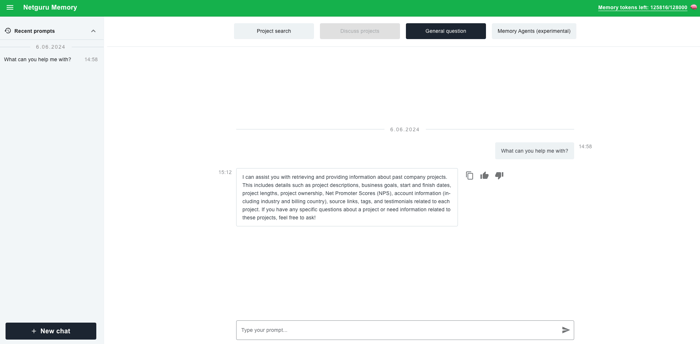
What is Netguru Memory
Netguru Memory is our AI assistant, which significantly improves the way we manage internal knowledge. I helped establish and build it as part of the development team.
If you, like us, have used Confluence and retain a lot of knowledge and experience, you have a lot of data. Netguru has dealt with 873 clients on 9257 projects, creating a vast store of information.
Utilizing Azure AI services, we can approach Netguru Memory with any R&D topic and get related info from past projects in seconds. Our devs can see how different technologies solved similar problems in the past and apply it to their current needs.
To make it work, we’ve combined many technologies into a stack, including:
- Typescript for developing the app;
- Azure for cloud services;
- AI for data retrieval and complex queries;
- Azure Cognitive Search for the knowledge base bot;
- Azure AI services to summarize content & general enhancement; and
- Salesforce to provide CRM and integrate with Azure AI services.
How does Netguru use it?
Netguru Memory assists us in storing, organizing, and sharing internal knowledge more effectively. Additionally, it improves our decision-making abilities and simplifies workflows. The tool helps us handle the issue of fragmented data storage, which frequently affects project delivery, business development, and marketing delays.
In the past, when people needed information about our experience with healthcare projects, it involved arduous retrieval. They had to ask around, dig through CRMs, documents, and presentations. It could take them days to find the right answers.
Now, Azure Cognitive Search service parses all the data and creates a search index. This index is used by GPT chat to find relevant information about past projects. All one has to do is ask Memory to prepare a project description and the task is completed in just minutes. There is no comparison in pure efficiency.
Netguru Memory key benefits:
The prime benefit, of course, is access to our internal data storage. But Memory can also offer recommendations regarding next steps, for example, whom you could reach out to for further details. And whether your query is about data or personnel, the search time is almost always under one minute.
AI development learning practice at Netguru
Our people have been using AI development tools for quite a while now, but there is always something new to learn. To stay abreast of change we have two initiatives in place:
R&D Weekly Workshops
During our R&D Workshops team members have the opportunity to witness specialists showcasing remarkable work in approximately 30 minutes. Each week, we focus on a specific use case, ensuring it is as practical as possible, without lengthy presentations, introductions, or conclusions. The objective of these workshops is to demonstrate possibilities, introduce novel approaches to work, and inspire individuals.
AI Development Workshop
Artificial intelligence is an integral part of our operations at Netguru, shaping how we serve our clients and assisting them in achieving their objectives. As such, a significant number of our recent workshops have been dedicated to AI-related topics.
These workshops cover a wide array of subjects. They range from highly specific use cases aimed at improving developers' skills to broader discussions addressing the implications of AI integration into our developers' tool stack. The first day of the workshop is dedicated to setup and exploration, where we install necessary software, libraries, and run various AI model examples locally. The following day, we focus on advanced applications. These include building and running a retrieval-augmented generation (RAG) system with FAISS and constructing an agent network to solve complex tasks.
Best AI tools for software developers that will aid in code completion
Some of the tools I’ve discussed in this post are widely available, so if you liked reading about their capabilities, you can use them the same way we do at Netguru. Other solutions were built internally, to closely fit our organization’s needs.
Copilot will help you fly through code development. GPT-Engineer will assist you in developing code with even less input. Locofy.ai will let you code the frontends for all sorts of apps just by designing it and creating the supporting code. Similarly, Memory manages our information so our devs can get answers to “How have we done this before, and what’s the best way to do it again?” in just seconds.
The bottom line is that all of these tools show just how powerful AI has gotten, and will be getting every year. Yes, there are plenty of AI-powered solutions you can choose from, and choosing the ones that are best for your organization might be a challenge.
I believe that the tools I’ve shared here, along with our approach towards using them at Netguru, can act as a source of inspiration. Make sure that the AI software fits your existing toolstack, team structure, and that it helps you tackle specific use cases efficiently. Furthermore, by leveragingcurrent IT outsourcing trends you can build upon your best engineering topics and drive innovative solutions.







